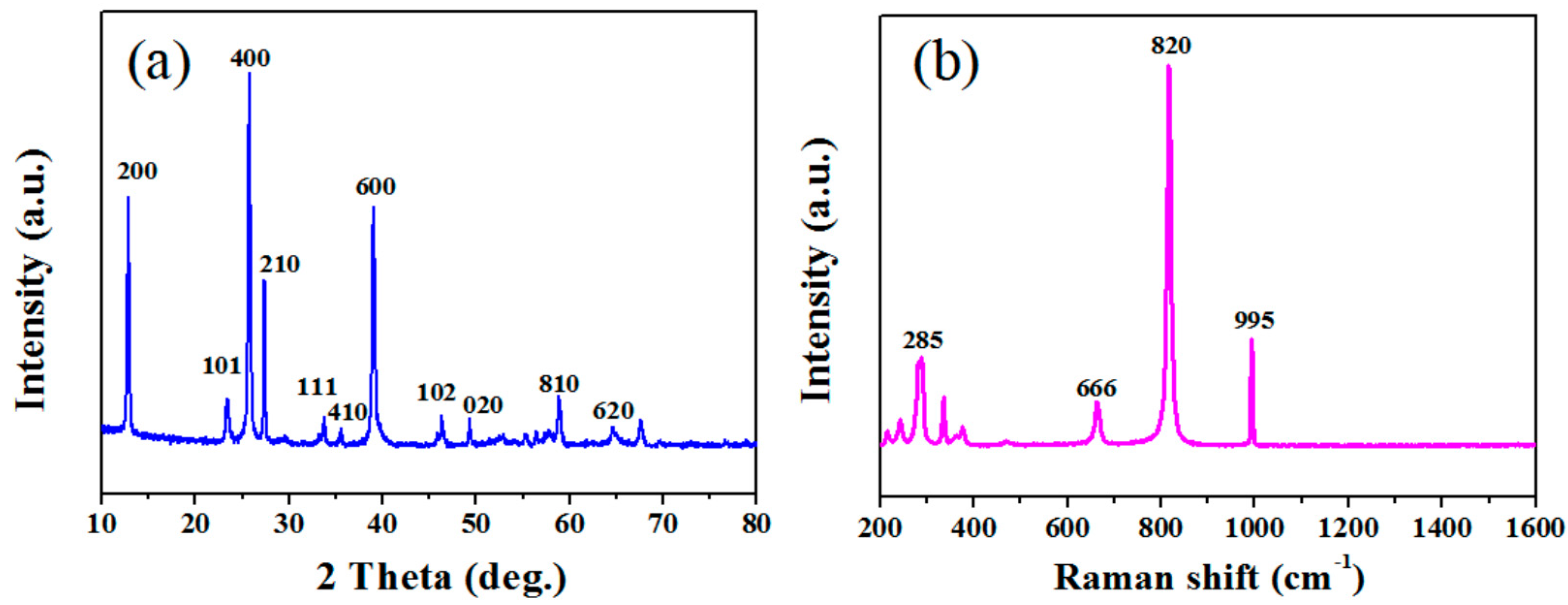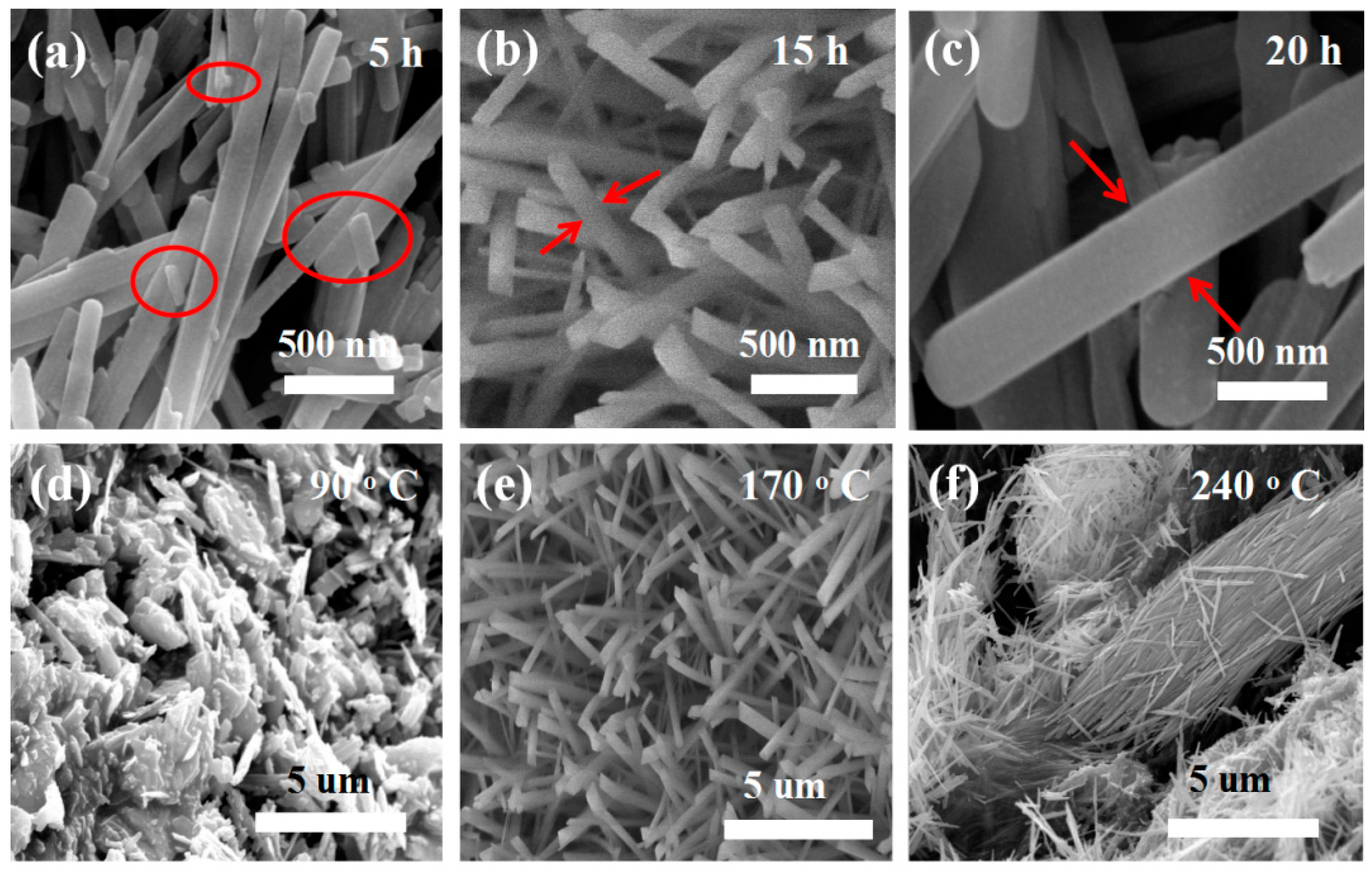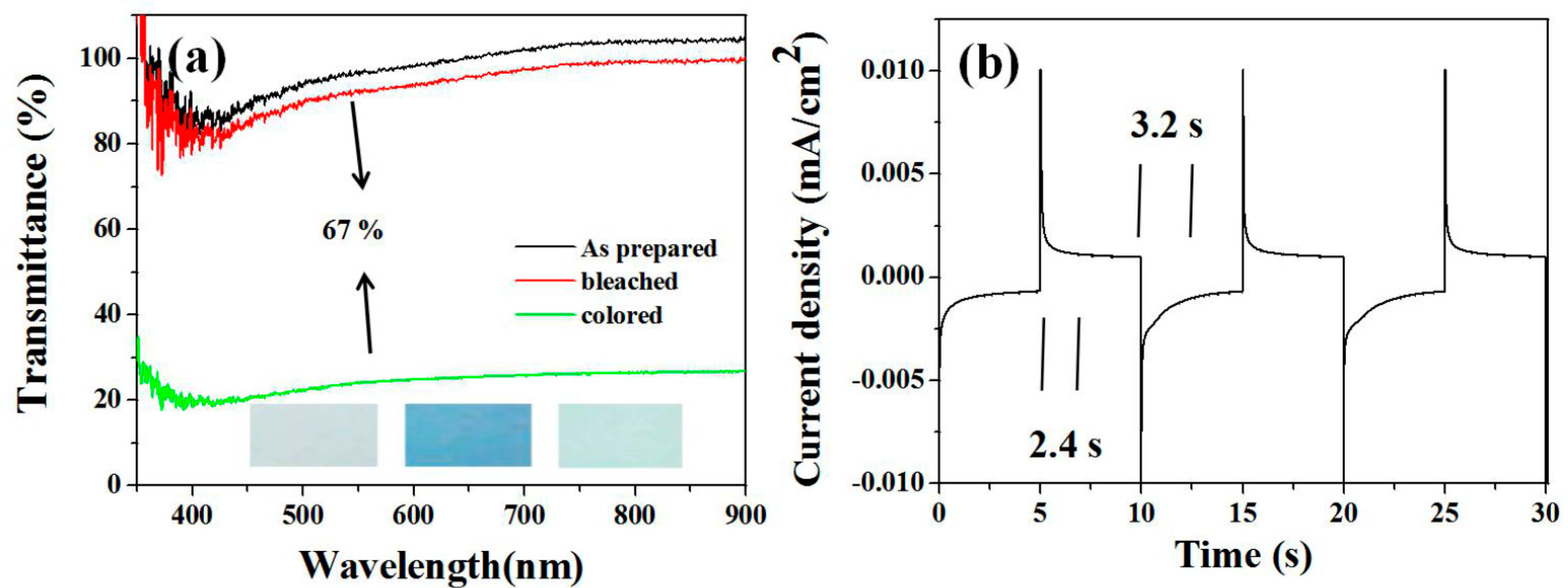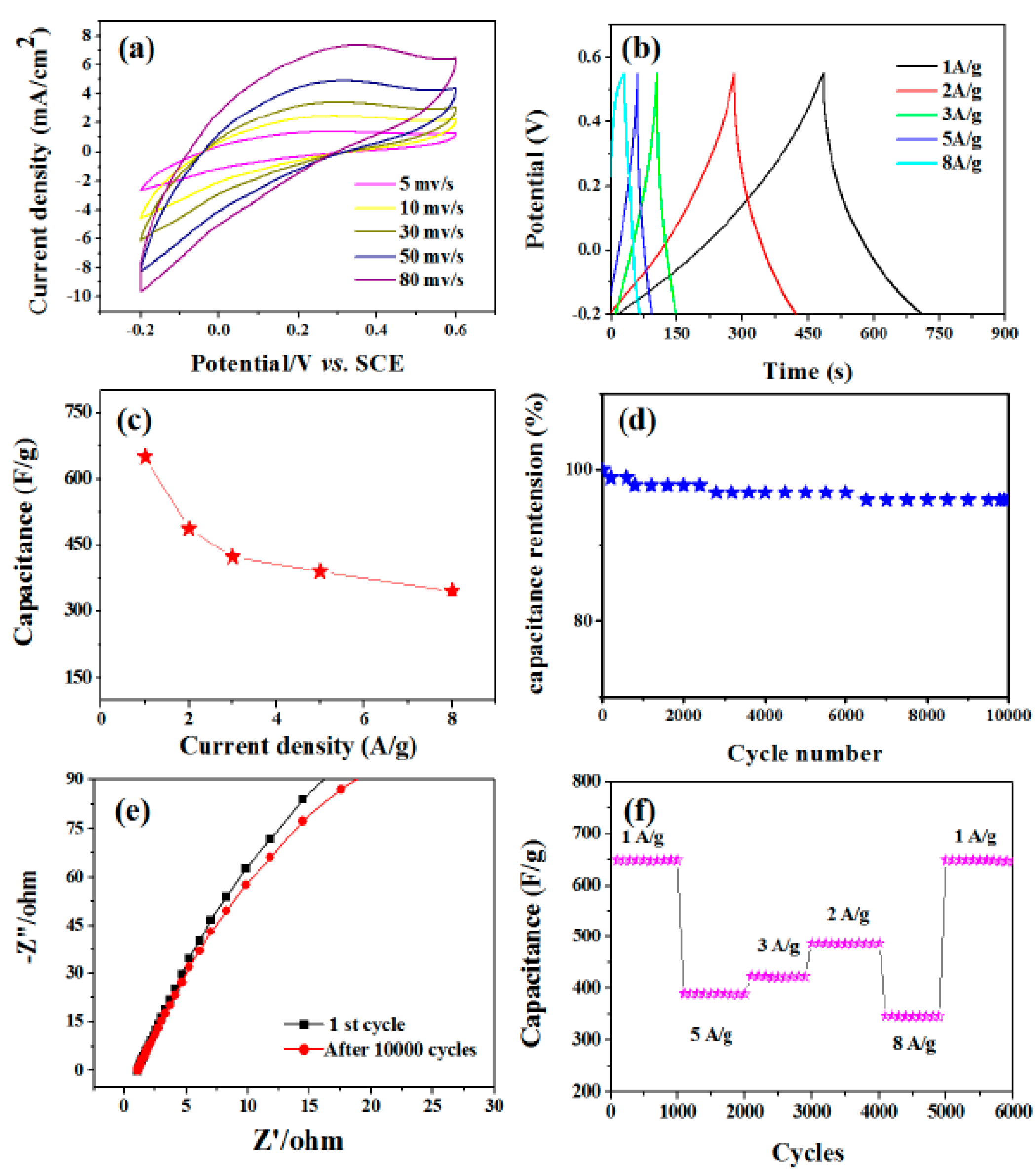Electrochromic Performance and Capacitor Performance of α-MoO3 Nanorods Fabricated by a One-Step Procedure
Abstract
:1. Introduction
2. Section of Experimentation
3. Results and Discussion
4. Conclusions
Author Contributions
Funding
Institutional Review Board Statement
Informed Consent Statement
Conflicts of Interest
References
- Zhou, S.; Wang, S.; Zhou, S.; Xu, H.; Zhao, J.; Wang, J.; Li, Y. An electrochromic supercapacitor based on an MOF derived hierarchical-porous NiO film. Nanoscale 2020, 12, 8934–8941. [Google Scholar] [CrossRef]
- Mahmood, N.; De Castro, I.A.; Pramoda, K.; Khoshmanesh, K.; Bhargava, S.K.; Kalantar-Zadeh, K. Atomically thin two-dimensional metal oxide nanosheets and their heterostructures for energy storage. Energy Storage Mater. 2019, 16, 455–480. [Google Scholar] [CrossRef]
- Wei, F.; Zhang, Q.; Zhang, P.; Tian, W.; Dai, K.; Zhang, L.; Mao, J.; Shao, G. Review-research progress on layered transition metal oxide cathode materials for sodium ion batteries. J. Electrochem. Soc. 2021, 168, 050524. [Google Scholar] [CrossRef]
- Jia, Y.; Lin, Y.; Ma, Y.; Zhou, S.; Shi, W. Branched nanowires-built MoO3 film with excellent electrochemical performance for energy storage. Mater. Lett. 2020, 280, 128567. [Google Scholar] [CrossRef]
- Low, W.H.; Khiew, P.S.; Lim, S.S.; Siong, C.W.; Ezeigwe, E.R. Recent development of mixed transition metal oxide and graphene/mixed transition metal oxide based hybrid nanostructures for advanced supercapacitors. J. Alloys Compd. 2019, 755, 1324–1356. [Google Scholar] [CrossRef]
- Yan, S.; Chen, Z.; Zhang, Y.; Yang, Y.; Dong, L. Ultrahigh polar phase content PVDF-based composite films with ultralow filler loading for high-energy-density flexible capacitors. J. Mater. Sci. Mater. Electron. 2021, 32, 12084–12093. [Google Scholar] [CrossRef]
- Novak, T.G.; Jin, K.; Tiwari, A.P.; Kim, J.; Jeon, S. 2D MoO3 Nanosheets synthesized by exfoliation and oxidation of MoS2 for high contrast and fast response time electrochromic devices. ACS Sustain. Chem. Eng. 2020, 8, 11276–11282. [Google Scholar] [CrossRef]
- Sharma, R.; Jha, R.; Sarkar, A.; Sharma, A.K.; Bhardwaj, R. Controlled growth of α-MoO3 nanostructures with enhanced optical and electrochemical properties without capping agents. Ceram. Int. 2020, 46, 23084–23097. [Google Scholar] [CrossRef]
- Cao, S.; Zhao, C.; Xu, J. A facile synthesis and controlled growth of various MoO3 nanostructures and their gas-sensing properties. SN Appl. Sci. 2019, 1, 1139. [Google Scholar] [CrossRef] [Green Version]
- Andron, I.; Marichez, L.; Jubera, V.; Labrugère, C.; Gaudon, M. Photochromic behavior of ZnO/MoO3 interfaces. ACS Appl. Mater. Interfaces 2020, 12, 46972–46980. [Google Scholar] [CrossRef]
- Adewinbi, S.A.; Taleatu, B.A.; Busari, R.A.; Maphiri, V.M.; Manyala, N. Synthesis and electrochemical characterization of pseudocapacitive α-MoO3 thin film as transparent electrode material in optoelectronic and energy storage devices. Mater. Chem. Phys. 2021, 264, 124468. [Google Scholar] [CrossRef]
- Ma, Y.; Jia, Y.; Lin, Y.; Shi, W. Hierarchical MoS2/MoO3 nanotubes with excellent electrochemical performance: MoS2 bubbles on MoO3 nanotubes. CrystEngComm 2019, 21, 6698–6702. [Google Scholar] [CrossRef]
- Shaheen, I.; Ahmad, K.S.; Zequine, C.; Gupta, R.K.; Malik, M.A. Effects of bioactive compounds on the morphology and surface chemistry of MoO3/ZnMoO4 nanocomposite for supercapacitor. J. Mater. Sci. 2020, 55, 7743–7759. [Google Scholar] [CrossRef]
- Jiang, X.; Tang, M.; Tang, L.; Jiang, N.; Lin, D. Hornwort-like hollow porous MoO3/NiF2 heterogeneous nanowires as high-performance electrocatalysts for efficient water oxidation. Electrochim. Acta 2021, 379, 138146. [Google Scholar] [CrossRef]
- Liu, J.; Quan, L.; Yu, X.; Wang, L. Quantitative detection of procalcitonin using an electrochemical immunosensor based on MoO3/Au@rGO nanocomposites. Analyst 2019, 144, 6968–6974. [Google Scholar] [CrossRef]
- Kumar, R.; Liu, X.; Zhang, J.; Kumar, M. Room-temperature gas sensors under photoactivation: From metal oxides to 2D materials. Nano-Micro Lett. 2020, 12, 292–328. [Google Scholar] [CrossRef]
- Thomas, T.; Jayababu, N.; Shruthi, J.; Mathew, A.; Reshmi, R. Room temperature ammonia sensing of α-MoO3 nanowires grown on glass substrates. Thin Solid Films 2021, 722, 138575. [Google Scholar] [CrossRef]
- Felix, A.A.; Silva, R.A.; Orlandi, M.O. Layered α-MoO3 nanoplates for gas sensing applications. CrystEngComm 2020, 22, 4640–4649. [Google Scholar] [CrossRef]
- Shen, S.K.; Cui, X.L.; Guo, C.Y.; Dong, X.; Xu, Y.M. Sensing mechanism of Ag/α-MoO3 nanobelts for H2S gas sensor. Rare Met. 2021, 40, 1545–1553. [Google Scholar] [CrossRef]
- Naresha, N.; Jenaab, P.; Satyanarayanaa, N. Facile synthesis of MoO3/rGO nanocomposite as anode materials for high performance lithium-ion battery applications. J. Alloys Compd. 2019, 810, 151920. [Google Scholar] [CrossRef]
- Teng, Y.; Zhao, H.; Zhang, Z.; Li, Y.; Liu, H. Self-assembly of flower-like MoO3-NiO microspheres with carbon coating as high-performance anode material for lithium-ion batteries. Mater. Lett. 2019, 246, 141–143. [Google Scholar] [CrossRef]
- Wu, J.; Lai, Q.; Zhong, C. Hydrothermal synthesis MoO3@CoMoO4 hybrid as an anode material for high performance lithium rechargeable batteries. Funct. Mater. Lett. 2019, 12, 1850104. [Google Scholar] [CrossRef]
- Zhou, H.; Jin, M.; Zhou, B.; Zhao, J.; Han, W. Porous nanotube networks of SnO2/MoO3@Graphene as anodes for rechargeable lithium-ion batteries. Nanotechnology 2021, 32, 095704. [Google Scholar] [CrossRef] [PubMed]
- Wu, Q.L.; Zhao, S.X.; Yu, L.; Yu, L.Q.; Wei, G. In situ synthesis and electrochemical performance of MoO3-x nanobelts as anode materials for lithium-ion batteries. Dalton Trans. 2019, 48, 12832–12838. [Google Scholar] [CrossRef]
- Lei, Z.; Yang, X.; Dong, J.; Yi, X. Novel metastable hexagonal MoO3 nanobelts: Synthesis, photochromic, and electrochromic properties. Chem. Mater. 2009, 21, 5681–5690. [Google Scholar] [CrossRef]
- Cai, L.; Rao, P.M.; Zheng, X. Morphology-controlled flame synthesis of single, branched, and flower-like α-MoO3 nanobelt arrays. Nano Lett. 2011, 11, 872–877. [Google Scholar] [CrossRef]
- Shakir, I.; Shahid, M.; Nadeem, M.; Kang, D.J. Tin oxide coating on molybdenum oxide nanowires for high performance supercapacitor devices. Electrochim. Acta 2012, 72, 134–137. [Google Scholar] [CrossRef]
- Aravinda, L.S.; Nagaraja, K.K.; Bhat, K.U.; Bhat, B.R. Magnetron sputtered MoO3/carbon nanotube composite electrodes for electrochemical supercapacitor. J. Electroanal. Chem. 2013, 699, 28–32. [Google Scholar] [CrossRef]
- Tang, G.; Zhang, F.; Xu, J. Facile synthesis of novel ultrathin α-MoO3 square nanosheets with excellent adsorptive capacity and photocatalytic performance for efficient treatment of Rhodamine B. Micro Nano Lett. 2019, 14, 416–419. [Google Scholar] [CrossRef]
- Ma, Q.; Li, X.; Li, G.; Shao, Z. Synthesis and electrochemical performance of MoO3 anode material prepared by polymer network gel method. Ionics 2021, 27, 157–164. [Google Scholar] [CrossRef]
- Guan, X.; Ren, Y.; Chen, S.; Yan, J.; Liu, C. Charge separation and strong adsorption-enhanced MoO3 visible light photocatalytic performance. J. Mater. Sci. 2020, 55, 5808–5822. [Google Scholar] [CrossRef]
- Ivanova, T.; Gesheva, K.; Hamelmann, F.; Popkirov, G.; Tzvetkova, E. Optical and electrochromic properties of CVD mixed MoO3-WO3 thin films. Vacuum 2004, 76, 195–198. [Google Scholar] [CrossRef]
- Lee, S.H.; Seong, M.J.; Tracy, C.E.; Mascarenhas, A.; Pitts, J.R.; Deb, S.K. Raman spectroscopic studies of electrochromic a-MoO3 thin films. Solid State Ion. 2002, 147, 129–133. [Google Scholar] [CrossRef]
- Qi, K.; Yang, J.; Fu, J.; Wang, G.; Zhu, L.; Liu, G.; Zheng, W. Morphology-controllable ZnO rings: Ionic liquid-assisted hydrothermal synthesis, growth mechanism and photoluminescence properties. CrystEngComm 2013, 15, 6729–6735. [Google Scholar] [CrossRef]
- He, K.; He, S.; Yang, W.; Tian, Q. Ag nanoparticles-decorated α-MoO3 nanowires for remarkable and rapid triethylamine-sensing response boosted by pulse-heating technique. J. Alloys Compd. 2019, 808, 151704. [Google Scholar] [CrossRef]
- Du, N.; Zhang, H.; Chen, B. Ligand-free self-assembly of ceria nanocrystals into nanowires by oriented attachment at low temperature. J. Phys. Chem. C 2007, 111, 12677–12680. [Google Scholar] [CrossRef]
- Cao, S.W.; Zhu, Y.J. Surfactant-free preparation and drug release property of magnetic hollow core/shell hierarchical nanostructures. J. Phys. Chem. C 2008, 112, 12149–12156. [Google Scholar] [CrossRef]
- Wang, J.; Qu, F.Y.; Wu, X. Photocatalytic degradation of organic dyes with hierarchical Ag2O/ZnO heterostructures. Sci. Adv. Mater. 2013, 5, 1364–1371. [Google Scholar] [CrossRef]
- Zhang, Q.; Liu, S.J.; Yu, S.H. Recent advances in oriented attachment growth and synthesis of functional materials: Concept, evidence, mechanism, and future. J. Mater. Chem. 2009, 19, 191–207. [Google Scholar] [CrossRef]
- Ma, X.J.; Kong, L.B.; Zhang, W.B.; Liu, M.C.; Luo, Y.C.; Kang, L. Design and synthesis of 3D Co3O4(male)MoO4 (M=Ni, Co) nanocomposites as high-performance supercapacitor electrodes. Electrochim. Acta 2014, 130, 660–669. [Google Scholar] [CrossRef]
- Xia, X.H.; Tu, J.P.; Zhang, Y.Q.; Mai, Y.J.; Zhao, X.B. Freestanding Co3O4 nanowire array for high performance supercapacitors. RSC Adv. 2012, 2, 1835–1841. [Google Scholar] [CrossRef]
- Singh, R.N.; Tiwari, S.K.; Singh, S.P.; Singh, N.K.; Poillerat, G.; Chartier, P. ChemInform abstract: Synthesis of (La, Sr)CoO3 perovskite films via a sol-gel route and their physicochemical and electrochemical surface characterization for anode application in alkaline water electrolysis. J. Chem. Soc. Faraday Trans. 1996, 92, 2593–2597. [Google Scholar] [CrossRef]
- Liang, K.; Tang, X.; Hu, W. High-performance three-dimensional nanoporous NiO film as a supercapacitor electrode. J. Mater. Chem. 2012, 22, 11062–11067. [Google Scholar] [CrossRef]







Publisher’s Note: MDPI stays neutral with regard to jurisdictional claims in published maps and institutional affiliations. |
© 2021 by the authors. Licensee MDPI, Basel, Switzerland. This article is an open access article distributed under the terms and conditions of the Creative Commons Attribution (CC BY) license (https://creativecommons.org/licenses/by/4.0/).
Share and Cite
Duan, Y.; Wang, C.; Hao, J.; Jiao, Y.; Xu, Y.; Wang, J. Electrochromic Performance and Capacitor Performance of α-MoO3 Nanorods Fabricated by a One-Step Procedure. Coatings 2021, 11, 783. https://doi.org/10.3390/coatings11070783
Duan Y, Wang C, Hao J, Jiao Y, Xu Y, Wang J. Electrochromic Performance and Capacitor Performance of α-MoO3 Nanorods Fabricated by a One-Step Procedure. Coatings. 2021; 11(7):783. https://doi.org/10.3390/coatings11070783
Chicago/Turabian StyleDuan, Ying, Chen Wang, Jian Hao, Yang Jiao, Yanchao Xu, and Jing Wang. 2021. "Electrochromic Performance and Capacitor Performance of α-MoO3 Nanorods Fabricated by a One-Step Procedure" Coatings 11, no. 7: 783. https://doi.org/10.3390/coatings11070783
APA StyleDuan, Y., Wang, C., Hao, J., Jiao, Y., Xu, Y., & Wang, J. (2021). Electrochromic Performance and Capacitor Performance of α-MoO3 Nanorods Fabricated by a One-Step Procedure. Coatings, 11(7), 783. https://doi.org/10.3390/coatings11070783







